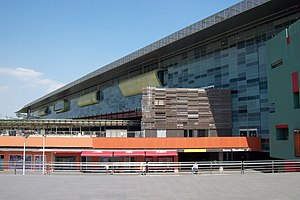Roma Tiburtina | |||||||
|---|---|---|---|---|---|---|---|
 | |||||||
| General information | |||||||
| Location | Piazzale Stazione Tiburtina 00100 Roma RM Italy | ||||||
| Coordinates | 41°54′37″N 12°31′51″E / 41.91028°N 12.53083°E, | ||||||
| Owned by | Rete Ferroviaria Italiana | ||||||
| Operated by | Grandi Stazioni | ||||||
| Line(s) | Florence–Rome (traditional) Rome–Florence (high-speed) Rome–Naples (high-speed) Rome–Pescara Rome–Ancona | ||||||
| Distance | 4.5 km (2.8 mi) from Roma Termini | ||||||
| Platforms | 20[1] | ||||||
| Connections |
| ||||||
| Construction | |||||||
| Architect | Paolo Desideri (2011 building) [1] | ||||||
| History | |||||||
| Opened | 1866 | ||||||
| Rebuilt | 28 November 2011 | ||||||
| Electrified | 3,000 V | ||||||
| |||||||
Roma Tiburtina is the second largest railway station in Rome, after Roma Termini. Located in the north-eastern part of the city, it was originally constructed during the 1860s as a terminal station, and redeveloped during the 2010's. The station is connected to Rome's Metro line B at Tiburtina metro station, as well as to local bus services via an adjacent bus depot while private vehicle users are provided with more than 100,000 spaces across multiple on-site car parks.
Roma Tiburtina originally opened in 1866, only three years after the first (temporary) Roma Termini. It was originally known as Portonaccio station, but all usage of this name has since been depreciated. During the 1930s, work was undertaken to expand the station, this included the development of a new main building. A rebuild was undertaken shortly after the end of the Second World War as a result of damage sustained from aerial bombing missions. During 1990, an adjoining metro station was opened, providing further means of local transit for passengers. Since the late 1990s, Roma Tiburtina station has been managed by Grandi Stazioni, a wholly owned entity of the Italian state railway operator Ferrovie dello Stato Italiane.
Between 2007 and November 2011, Roma Tiburtina was subject to an extensive redevelopment programme, during which much of the original station building and infrastructure were demolished and replaced, and new on-site facilities established.
Originally, these works were meant to transform Tiburtina into the main Rome station for high-speed rail services on the Milan-Naples line: being a through station, trains travelling from Turin/Milan to Naples/Salerno would not have any need to turn around. However, for undisclosed reasons, this project was never achieved and Roma Termini continue being the main Rome station for high speed trains.
The station is now dedicated to the traditional regional trains and to some less frequent high speed trains. The new station was projected to reach a daily ridership of over 45,000 by 2015.[2][3][4]
The station is currently served by 500 trains and 140,000 passenger transits per day (51 million users per year).[5]
- ^ a b "Tiburtina, via alla nuova stazione il primo hub per l'Alta velocità" [Tiburtina, a new station for the new High Speed hub]. la Repubblica (in Italian). Rome. 28 November 2011. Retrieved 28 November 2011.
- ^ "Roma Tiburtina (quasi) completa" [Rome Tiburtina (semi) complete]. CityRailways (in Italian). 28 November 2011. Retrieved 2 September 2017.
- ^ Fulloni, Alessandro (28 November 2011). "Tiburtina, 140 treni al giorno per l'Alta Velocità: 330 milioni di costi, 20 binari e 50mila mq" [Tiburtina, 140 trains per day for High Speed: 330 million cost, 20 tracks and 50 thousand square meters]. Corriere della Sera (in Italian). Milan. Retrieved 3 September 2017.
- ^ "Roma Tiburtina Railway Station, Rome". RailwayTechnology. 4 March 2012. Retrieved 28 June 2024.
- ^ "Rome Tiburtina Station". Rome: Ferrovie dello Stato Italiane. Retrieved 28 June 2024.
